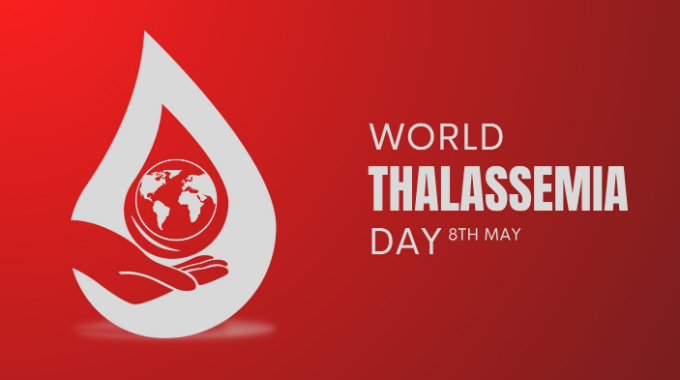
Since 1994, every year on 8th May, Thalassemia International Federation observes World Thalassemia Day. This year the theme of World Thalassemia Day 2023 is “Be Aware. Share. Care: Strengthening Education to Bridge the Thalassemia Care Gap”[1].
Thalassemia is an inherited or genetic blood disorder that produces either no or very less hemoglobin, the protein in red blood cells that carries oxygen [2]. Depending on the severity, thalassemia can be minor, intermedia, or major with minor showing no or very fewer symptoms requiring no treatment usually, intermedia for which transfusion therapy may be uncommon but chelation therapy may be necessary, and major may show severe symptoms for which both transfusion and chelation therapy are mandatory.
Here are some ways that individuals with thalassemia can adopt healthy lifestyle choices to manage their symptoms timely:
1. Nutrition: Fueling your body with the right nutrition is essential in managing thalassemia.
-Iron-When it comes to iron consumption, non-transfused thalassemia patients are recommended to refrain from high-iron and iron-supplemented foods. However, they are advised to consume a well-balanced diet to overcome folic acid deficiencies. People with thalassemia who are transfused need to follow an iron-restricted diet to prevent iron overload. You may be advised to limit your intake of iron-rich foods such as red meat, liver, clams, and oysters and avoid consuming foods that are fortified with iron, such as certain breakfast cereals. Instead, are recommended to increase the intake of iron-free alternatives, such as non-heme iron found in vegetables, beans, and fortified grains [4].
-For non-transfused or on low transfusion patients who may develop a folic acid deficiency, a daily supplement of 1mg/day is recommended [5].
-Both transfused and non-transfused patients need to load up on calcium and vitamin D-rich foods with daily supplements of 1,000 mg/day and 2,000 IU/day respectively to maintain bone health [6].
Take control of your thalassemia care with our specially formulated multivitamins and supplements. Shop now!
2. Exercise: It is a no-brainer that exercise can help improve overall health and well-being. While some people with thalassemia may face issues in vigorous forms of exercise, most people with thalassemia can safely indulge in moderate to low-impact exercises like biking, yoga, walking, etc. It is essential to start slowly and gradually and understand what works best in your case[6].
Consult a doctor before starting any exercise program to ensure it is safe and appropriate for your condition. Contact experts right away!
3. Vaccinations: Immunizations and vaccinations can protect against a variety of infections. This is especially critical for patients who are on chronic transfusions or who have had their spleens removed, as these conditions can render them more susceptible to infections. Meningococcal vaccination, Haemophilus influenzae type b (Hib), and Pneumococcal vaccines should be administered to splenectomized individuals [3].
Don’t take chances with your health. Vaccinations can help prevent serious infections for people with thalassemia. Explore here!
4. Maintaining Good Oral Health: Dental health is important for thalassemia patients, as they may be at risk of developing oral infections due to their frequent blood transfusions. At later stages, regular transfusions can also cause the malformation of facial bones in such patients giving rise to malocclusions [5][6].
5. Sexual and Reproductive life: Hormonal deficiencies such as delayed puberty, hypogonadism, and lack of menses (amenorrhea) may result in fertility problems. Men with thalassemia may not produce enough sperms and women may not ovulate. However, with hormone replacement therapy and fertility treatments like IVF, this issue can be taken care of [6].
6. Smoking and Alcohol Consumption: It can worsen iron overload in individuals with thalassemia leading to worsening complications such as organ damage and heart disease. Along with decreased bone formation and bone remodeling, smoking and alcohol can also lead to osteoporosis [5][6].
Consider using nicotine replacement therapy or other smoking cessation aids, such as patches, gum, or medication, to help you quit. Click to begin your smoking cessation journey!
7. Travel with Caution: Travelling with thalassemia requires careful planning and preparation to ensure safety. With a weakened immune system, people with thalassemia should avoid traveling to areas with a high risk of infection. Travel insurance with a sufficient supply of chelation drugs can help overcome emergency situations [5][6].
8. Managing Stress: People with this condition are prone to severe stress, depression, and low self-esteem. Psychological support through counseling, therapy, and support groups, along with education about the disease can help manage stress in both the patients as well their caregivers. The support groups like Cooley’s Anemia Foundation as well as transfusion centres help navigate the psychological aspects of living with the condition by giving patients and their families an opportunity to communicate, connect and update them with the latest information[6][8].
Living with thalassemia requires a proactive approach to health and wellness. With healthy lifestyle choices and medical interventions like vaccinations, individuals with thalassemia can lead fulfilling lives, empowered to take control of their condition and minimize its impact on their daily lives.
(The article is written by Dr.Subita Alagh, Senior Executive, and reviewed by Dr. Swati Mishra, Medical Editor)
References:
1. Centers for Disease Control and Prevention: What is Thalassemia? https://www.cdc.gov/ncbddd/thalassemia/facts.html
2. Centers for Disease Control and Prevention: Healthy Living with Thalassemia
https://www.cdc.gov/ncbddd/thalassemia/living.html
3. Living with Thalassemia
https://thalassemia.com/nutrition-diet-nontransfused.aspx#gsc.tab=0
4. NIH: General Health Care and Lifestyle in Thalassaemia
https://www.ncbi.nlm.nih.gov/books/NBK173970/
5. A Guide to Living with Thalassemia: Chapter 7 Healthy Living
https://www.thalassemia.org/wp-content/uploads/2022/09/GuideToLivingWithThalassemia.pdf
6. NHS: Living with Thalassaemia
https://www.nhs.uk/conditions/thalassaemia/living-with/
7. Inamdar S, Inamdar M, Gangrade A. Stress Level among Caregivers of Thalassemia Patients. Ntl J of Community Med 2015; 6(4):579-582
https://njcmindia.com/index.php/file/article/view/1283/1027